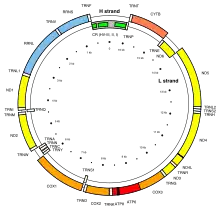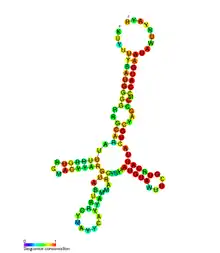mtDNA-Kontrollregion
mtDNA-Kontrollregion (synonym DLP-Region von ‚D-Loop und Promotor-Region‘)[1] ist ein nichtcodierender Abschnitt auf der mitochondrialen DNA (mtDNA), der die Replikation und die Transkription der mtDNA kontrolliert.
| Nukleinsäure | |
|---|---|
 | |
| Karte der mtDNA mit der mtDNA-Kontrollregion (grau und grün) | |
| Allgemeines | |
| Name | mtDNA-Kontrollregion |
| Andere Namen |
|
| Identifikatoren | |
| GenBank | |
| Eigenschaften | |
| Taxon | |
Eigenschaften

Die mtDNA-Kontrollregion ist der größte nichtcodierende Bereich der mtDNA.[2] Aufgrund zweier hypervariabler Regionen ist sie auch der Bereich der mtDNA mit der variabelsten DNA-Sequenz.[2] Sie enthält den mitochondrialen Replikationsursprung für einen der beiden DNA-Stränge, den D-Loop und beide Transkriptionsstartpunkte.[2][3] Die Variabilität liegt bei etwa 1,7 %.[4] Dennoch liegt bei der transkribierten RNA ein Selektionsdruck auf dem Erhalt der Sekundärstruktur.[5] Allerdings wurden zwei Deletionen (von 50 Basenpaaren und 154 Bp) ohne Auswirkungen auf die mtDNA-Kopieanzahl beschrieben.[6] Bestimmte Varianten der mtDNA-Kontrollregion sind mit einer vergrößerten Ausdauer assoziiert.[7]
Methoden zur Unterscheidung von DNA-Sequenzen der mtDNA-Kontrollregion sind DNA-Sequenzierung, dHPLC und Microarrays.[8]
Einzelnachweise
- Y. Michikawa, F. Mazzucchelli, N. Bresolin, G. Scarlato, G. Attardi: Aging-dependent large accumulation of point mutations in the human mtDNA control region for replication. In: Science. Band 286, Nummer 5440, Oktober 1999, S. 774–779, PMID 10531063.
- M. Stoneking, D. Hedgecock, R. G. Higuchi, L. Vigilant, H. A. Erlich: Population variation of human mtDNA control region sequences detected by enzymatic amplification and sequence-specific oligonucleotide probes. In: American Journal of Human Genetics. Band 48, Nummer 2, Februar 1991, S. 370–382, PMID 1990843, PMC 1683035 (freier Volltext).
- S. Anderson, A. T. Bankier, B. G. Barrell, M. H. de Bruijn, A. R. Coulson, J. Drouin, I. C. Eperon, D. P. Nierlich, B. A. Roe, F. Sanger, P. H. Schreier, A. J. Smith, R. Staden, I. G. Young: Sequence and organization of the human mitochondrial genome. In: Nature. Band 290, Nummer 5806, April 1981, S. 457–465, PMID 7219534.
- C. F. Aquadro, B. D. Greenberg: Human mitochondrial DNA variation and evolution: analysis of nucleotide sequences from seven individuals. In: Genetics. Band 103, Nummer 2, Februar 1983, S. 287–312, PMID 6299878, PMC 1219980 (freier Volltext).
- F. Pereira, P. Soares, J. Carneiro, L. Pereira, M. B. Richards, D. C. Samuels, A. Amorim: Evidence for variable selective pressures at a large secondary structure of the human mitochondrial DNA control region. In: Molecular biology and evolution. Band 25, Nummer 12, Dezember 2008, S. 2759–2770, doi:10.1093/molbev/msn225, PMID 18845547.
- R. Bi, A. M. Zhang, W. Zhang, Q. P. Kong, B. L. Wu, X. H. Yang, D. Wang, Y. Zou, Y. P. Zhang, Y. G. Yao: The acquisition of an inheritable 50-bp deletion in the human mtDNA control region does not affect the mtDNA copy number in peripheral blood cells. In: Human mutation. Band 31, Nummer 5, Mai 2010, S. 538–543, doi:10.1002/humu.21220, PMID 20151402.
- H. Murakami, A. Ota, H. Simojo, M. Okada, R. Ajisaka, S. Kuno: Polymorphisms in control region of mtDNA relates to individual differences in endurance capacity or trainability. In: The Japanese journal of physiology. Band 52, Nummer 3, Juni 2002, S. 247–256, PMID 12230801.
- T. Melton, C. Holland, M. Holland: Forensic Mitochondrial DNA Analysis: Current Practice and Future Potential. In: Forensic science review. Band 24, Nummer 2, Juli 2012, S. 101–122, PMID 26244267.